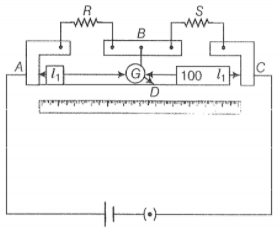In a meter bridge, point D is a neutral point as shown in the figure.
| a. | The meter bridge can have no other neutral point for this set of resistances. |
| b. | When the jockey contacts a point on the meter wire left of D, current flows to B from the wire. |
| c. | When the jockey contacts a point on the meter wire to the right of D, current flows from B to the wire through the galvanometer. |
| d. | When R is increased, the neutral point shifts to left. |

Which of the above statements is correct?
1. (a, c)
2. (a, d)
3. (b, c)
4. (c, d)

© 2026 GoodEd Technologies Pvt. Ltd.